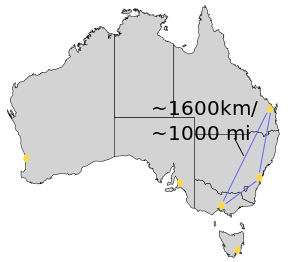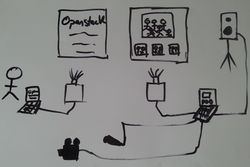Difference between revisions of "OpenStackUserGroups/LinkingRemoteMeetups"
(→Setup) |
(→Setup) |
||
| Line 32: | Line 32: | ||
==Setup== | ==Setup== | ||
Each location needs at least one laptop and projector, and a high quality microphone and webcam. We've used Logitech C910 (http://www.logitech.com/en-au/product/6816?crid=34), Logitech Webcam Pro 9000, and Chat 150 (http://www.clearone.com/products_chat150) with success - but many options work! The most crucial aspect is planning the setup and testing it before the event - true remote participation only works if it is given a high priority. | Each location needs at least one laptop and projector, and a high quality microphone and webcam. We've used Logitech C910 (http://www.logitech.com/en-au/product/6816?crid=34), Logitech Webcam Pro 9000, and Chat 150 (http://www.clearone.com/products_chat150) with success - but many options work! The most crucial aspect is planning the setup and testing it before the event - true remote participation only works if it is given a high priority. | ||
| + | |||
| + | |||
[[File:Meetup_dual_projectors.jpg|right|250px]] | [[File:Meetup_dual_projectors.jpg|right|250px]] | ||
| − | As an example, in Melbourne, the room is setup with dual projectors and laptops. | + | Ideally, multiple laptops and projectors can be used. As an example, in Melbourne, the room is setup with dual projectors and laptops. |
One laptop is responsible for: | One laptop is responsible for: | ||
Latest revision as of 05:29, 25 May 2013
This article contains some information about the potential of linking remote OpenStack meetups, using a recent Australian tri-city meetup as an example.
Context
Australia is a large continent (similar in size to the USA), but with a very sparse population. In planning our community, it was clear from the begining that having separate meetup groups in each city was likely to result in fragments so small they never grew. We decided to form a national umbrella group, and coordinate events at that level until each city/state group become sufficiently large to take over.
Most recently, we've organised a tri-city meetup - in the east coast cities of Brisbane, Sydney and Melbourne. This is our 19th meetup, and we're trying to use our experience from previous half-hearted attempts to link the three sites for remote participation in a serious manner.
| City | Attendees | Speakers |
|---|---|---|
| Brisbane | 20 | 0 |
| Sydney | 50 | 4 |
| Melbourne | 60 | 3 |
Requirements and Software
In Melbourne and Sydney - locations with speakers locally and remote, we needed a system that was able to provide both send and receive screen sharing, in addition to speaker and audience video and audio. In Brisbane, requirements were slightly simpler in that there was only the need to recieve screen sharing, but we still expected to be able to take questions from the audience there.
We tried a range of software, before we determined that the best software application for our needs was Google Hangouts.
- Skype (needs paid version, but still doesn't work with multi-way video if some clients eg linux are present)
- BlueJeans (paid product, but had poorer quality video than Hangouts and interesting client problems)
- GoToMeeting (paid product, our account expired, but has very poor linux support)
- SeeVogh (paid product, but caused several of our machines to run at 100% CPU causing streaming issues)
Google Hangouts allowed high quality video and audio, in addition to simple screen sharing. In addition, the "On Air" functionality allows us to stream live to participants who can't get to a meetup location, and provide a recording for those who couldn't make it.
Setup
Each location needs at least one laptop and projector, and a high quality microphone and webcam. We've used Logitech C910 (http://www.logitech.com/en-au/product/6816?crid=34), Logitech Webcam Pro 9000, and Chat 150 (http://www.clearone.com/products_chat150) with success - but many options work! The most crucial aspect is planning the setup and testing it before the event - true remote participation only works if it is given a high priority.
Ideally, multiple laptops and projectors can be used. As an example, in Melbourne, the room is setup with dual projectors and laptops.
One laptop is responsible for:
- projecting slides
- sharing local slides to remote locations
- local speaker audio transmission
The second laptop is responsible for:
- local speaker video transmission
- remote speaker audo/video receival
- local/remote audience audio/video tx&rx
Important notes:
- Slide sharing on Google Plus requires a lot of system resources - it's important to have an appropriately specified machine
- Only ever have one microphone in the entire three-city setup un-muted at any time - to avoid feedback loops
- This requires a bit of bandwidth. We had to work with our venues to ensure there was sufficient bandwidth available - wifi generally does not work.


